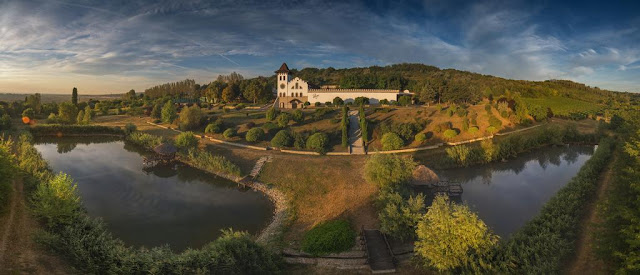 |
| Tissot-Marie Crémant du Jura Lapiaz Brut with Fried Pork Skin, Dill-infused Cheese, Pitted Dates and Almond |
#Winophiles bloggers are taking a virtual journey to the smallest wine region, Jura in France in November. David Crowley from Cooking Chat Food is inviting us to share the delicious pairings of Jura wines with our choice of food. I have purchased a bottle of Tissot-Marie Crémant du Jura Brut Lapiaz and found it exceptionally tasty with snacks like the fried pork skin. To start, let’s learn some fun facts of Jura wines.
 |
| Photo Credit: Wine LoveToKnow |
Ten Facts of Jura Wines
- Jura is the smallest wine region in eastern France, between Burgundy and Switzerland.
- The climate in Jura is continental - long cold winters and hot summers, with more rain nearing the Burgundy side of the region.
- Jura is famous for the idiosyncratic sherry-like late-harvest wine Vin Jaune, made in the Château-Chalon AOC.
- Other important grape varieties in Jura include Pinot Noir, Poulsard, Trousseau, Chardonnay and Savagnin.
- Chardonnay is the Jura's most planted variety, and the growing success of Crémant du Jura has benefited from the unripe grapes that are used as the sparkling base.
- There are seven AOCs (Appellation d'Origine Contrôlée) in Jura, namely Arbois, Château-Chalon, Côtes du Jura, L'Étoile, Crémant du Jura, Macvin du Jura and Marc du Jura,
- Crémant du Jura is an AOC for sparkling wines. White and rosé sparkling wines are produced from Poulsard, Trousseau, Pinot Noir, Chardonnay, Pinot Gris, and Savagnin.
- Crémant du Jura is made in the méthode traditionelle, like champagne and is styled from bone-dry to delicately sweet.
- The vineyard soils throughout the region tend to contain mostly clay in the lower flat lands with more limestone based soils in the higher elevation.
- Due to the cool climate, chaptalization, which is the process to add sugar to unfermented grape to achieve the desired alcohol content, is permitted in the Jura region and is sometimes a necessity to compensate for the low sugar levels in the underripen vintages.
Tissot-Marie Crémant du Jura Brut Lapiaz
Tissot-Marie Crémant du Jura Brut Lapiaz is one of the five Crémants, jointly produced by Henri Maire et Tissot and Groupe Boisset. Founded by Joseph Tissot in 1896, Maison Tissot started to sell wines before partnering with Henri Maire in early 2000s. Domaine Maire & Fils, another major Jura wine family, started its wine journey back in 1632. In 2000, the Tissot family draws closer to Domaine Maire & Fils, a long-time local partner and gives birth to Tissot-Maire, an alliance of winemaking knowledge inherited from more than 11 generations and with the largest winegrowing estate in the Jura region, to produce top-notched Crémants.
 |
| The company logo symbolizes the alliance of Tissot and Marie, two great Jura families, the connection with local traditional arts and craft, and the complexity that comes with winemaking |
 |
| Tissot-Marie Cuvée Crémant du Jura Brut Lapiaz (SRP$18) - a blend of Chardonnay (50%) and Pinot Noir (50%) |
Food Pairing
To pair with this fresh and
elegant Crémant, I put together a quick snacking plate that includes some dill-infused
cheese, unsalted almond, pitted dried dates and store-bought fried pork skin. I’m
particularly fond of the fried pork skin with this Crémant as the wine tones
down the fattiness of the pork skin and the rich pork taste. Its bubble is so
fun when it mingles with the crunch of the pork skin.
Check out other #Winophiles
bloggers’ Jura wine journey and fun food pairings:
Camilla from Culinary Adventures with Camilla will share "Seafood B'Stilla + Domaine Rolet Arbois Trousseau 2012"
Pinny from Chinese Food and Wine Pairings is "Sipping Tissot-Marie Crémant Du Jura and Snacking Fried Pork Skin"
Linda from My Full Wine Glass will be heading "Back to the Jura (virtually), for Crémant this time around"
Robin from Crushed Grape Chronicles is "Channeling the Jura for a rooftop getaway with a bottle of Savagnin and Friends"
Payal from Keep the Peas is sharing "Sherry? No, Jura"
David from Cooking Chat will be sharing "Slow Cooker BBQ Chicken Thighs with Jura Wine"
Terri from Our Good Life will tell us about "Sparkling Jura for Celebratory Moments"
Wendy from A Day in the Life on the Farm will serve up "Bourride served with a Chardonnay from Jura"
Nicole from Somm's Table will be "Cooking to the Wine: Two Savagnins from Domaine Daniel Dugois with Coquilles St. Jacques"
Christy from Confessions of a Culinary Diva is talking about "Jura in the Afternoon"
Gwendolyn from Wine Predator will share "Exploring Flavors of Jura Food and Wine Take Two: Trousseau and Melon"
Susannah from Avvinaire tells us about "Discovering Delights From Jura Region"


















